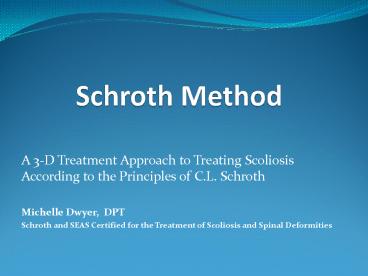Schroth Method PowerPoint PPT Presentation
1 / 31
Title: Schroth Method
1
Schroth Method
- A 3-D Treatment Approach to Treating Scoliosis
According to the Principles of C.L. Schroth - Michelle Dwyer, DPT
- Schroth and SEAS Certified for the Treatment of
Scoliosis and Spinal Deformities
2
U.S. History- Challenging the Current Model
- Parents- Too much wait and see
- Patients- Lack of knowledge regarding how to
help themselves beyond bracing and waiting - Therapists- Inadequately educated and equipped
in scoliosis treatment - Orthotists-Traditional bracing lacks 3-D
corrections, resulting in flat back and other
poor cosmetic changes - Doctors- Is there a way to help patients
sooner?
3
Traditional PT
- Postural Awareness
- Stretching/ Strengthening
- Hip ROM
- Spinal Stability
- Body Mechanics
4
Challenging the Traditional Model of PT
- Schroth Based PT - Barcelona Physical Therapy
School - SEAS
- - ISICO, Stephano Negrini MD, Milan, Italy
- Team Approach
- PCP/ Pediatrician, Orthotist,
Orthopedic/Neurosurgeon, - Other?
- Community Involvement
- Curvy Girls, Hopes Closet, local meeting and
support groups.
5
Schroth ( BSPTS) Principles
- Primarily Adolescent Idiopathic Scoliosis
Treatment - Deformities in the Sagittal Plane (
Scheurmanns, Hyper-Kyphosis and Hyper- Lordosis - Curve Specific
- Cognitive, sensory- motor, kinesthetic,
neuromuscular - exercises to reduce scoliosis posture
6
History and Goals
- Germany 1921
- Inpatient
- Spain 1968
- Outpatient
- USA 2005
- First certified therapists
- 2011 First US course held Stevens Point, WI
- Correct scoliosis posture
- Reduce risk of progression
- Strengthen asymmetrically
- Improve respiration
- Diminish functional limitations
- Reduce pain
- Improve body mechanics
- Improve self image and quality of life
7
Treatment Guidelines
- Precautions
- Osteoporosis
- Post- Surgery
- Juvenile Hypermobility Syndrome (JHS)
- Osteogenesis Imperfecta
- Spondylolisthesis
- Contraindications
- Reactive Scoliosis (tumor, disease, etc)
- Inflammatory diseases- during active phase
- Psychiatric Issues
8
Treatment Guidelines
- May be treated but with limitations
- Syndromic and Neuromuscular Scoliosis
- Post Surgery
- Adult Degenerative Scoliosis
- Infantile (Age 0-3), Juvenile (age 4-9)
SRS Classification
9
Treatment Guidelines
- Risk of Progression Factor
- Patient Age
- Risser Score
- Cobb Angle
- Age patient is first seen
10
Assessment
- Screening- Adams Test
- Angle of Trunk Rotation- (ATR) Using
Scoliometer - gt5 in sitting Screen
- Postural- Frontal, Sagittal and Aerial
- X- Ray- Cobb, Apex, Rotations, CSL, Risser
- Height Measurement Sitting and Standing
- Vital Capacity
- Thoracic Function
- Pain
- Quality of Life SRS 22, SRS 36, TAPS, QLSPD
11
(No Transcript)
12
Schroth Exercises
- Prone on Knees-Transverse Plane Anterior
Gravity Assisted
- Semi-Hanging Sagittal Plane
13
Schroth Exercise
- Standing 3D Correction
- Supine Gravity Assisted- Transverse Plane
14
Assessment Photos
15
Assessment Photos
16
In Brace Correction
17
Pre/ Post Brace Comparison
- In Brace X- Ray
- Pre Brace X-Ray
18
Sagittal Plane Correction
- Visit 3
- Visit 1
19
Exercises Using Schroth Principles
20
Exercises Using Schroth Principles
- Visit 1 - Uncorrected
- Visit 3 - Corrected Posture
21
Exercises Sport Specific and In-Brace
22
Sport Specific Training In Corrected Posture
23
Case Study
- Visit 1
- Visit 1
24
Sagittal Visit 1
25
Visit 2 Sagittal Plane Correction
- Sagittal Correction
- Psoas Stretch
26
Stretching- Stabilization
- Supine Hamstring Stretch
- Scapular / Core Stability
27
Sagittal Correction
- Visit 1
- Visit 6 - 2 month follow up
28
Patient Follow Up
- Visit 1
- 2 Month follow up
29
PT Treatment Options
- Local Program
- Basic Program 2x wk- 8wks
- Progression
- Monthly, Quarterly, Bi-Annually
- Until Risser 5
- Immersion Program
- Basic Program for 5 consecutive days
- Progression
- First yr every 3 months
- Bi-Annually to Risser 5
30
(No Transcript)
31
Assistants

